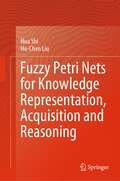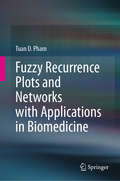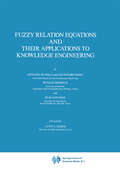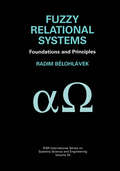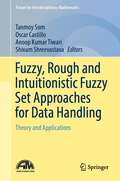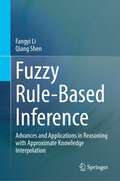- Table View
- List View
Fuzzy Optimization: Recent Advances and Applications (Studies in Fuzziness and Soft Computing #254)
by Weldon A. Lodwick Janusz KacprzykOptimization is an extremely important area in science and technology which provides powerful and useful tools and techniques for the formulation and solution of a multitude of problems in which we wish, or need, to to find a best possible option or solution. The volume is divided into a coupe of parts which present various aspects of fuzzy optimization, some related more general issues, and applications.
Fuzzy Petri Nets for Knowledge Representation, Acquisition and Reasoning
by Hua Shi Hu-Chen LiuThis book provides valuable knowledge, useful fuzzy Petri nets (FPN) models, and practical examples that can be considered by mangers in supporting knowledge management of organizations to increase and sustain their competitive advantages. In this book, the authors proposed various improved FPN models to enhance the modeling power and applicability of FPNs in knowledge representation and reasoning. This book is useful for practitioners and researchers working in the fields of knowledge management, operation management, information science, industrial engineering, and management science. It can also be used as a textbook for postgraduate and senior undergraduate students.
Fuzzy Pictures as Philosophical Problem and Scientific Practice: A Study of Visual Vagueness (Studies in Fuzziness and Soft Computing #348)
by Jordi CatThis book presents a comprehensive discussion on the characterization of vagueness in pictures. It reports on how the problem of representation of images has been approached in scientific practice, highlighting the role of mathematical methods and the philosophical background relevant for issues such as representation, categorization and reasoning. Without delving too much into the technical details, the book examines and defends different kinds of values of fuzziness based on a complex approach to categorization as a practice, adopting conceptual and empirical suggestions from different fields including the arts. It subsequently advances criticisms and provides suggestions for interpretation and application. By describing a cognitive framework based on fuzzy, rough and near sets, and discussing all of the relevant mathematical and philosophical theories for the representation and processing of vagueness in images, the book offers a practice-oriented guide to fuzzy visual reasoning, along with novel insights into the field of interpreting and thinking with fuzzy pictures and fuzzy data.
Fuzzy Portfolio Optimization: Theory and Methods (Lecture Notes in Economics and Mathematical Systems #609)
by Yong Fang Kin Keung Lai Shouyang WangMost of the existing portfolio selection models are based on the probability theory. Though they often deal with the uncertainty via probabilistic - proaches, we have to mention that the probabilistic approaches only partly capture the reality. Some other techniques have also been applied to handle the uncertainty of the ?nancial markets, for instance, the fuzzy set theory [Zadeh (1965)]. In reality, many events with fuzziness are characterized by probabilistic approaches, although they are not random events. The fuzzy set theory has been widely used to solve many practical problems, including ?nancial risk management. By using fuzzy mathematical approaches, quan- tative analysis, qualitative analysis, the experts’ knowledge and the investors’ subjective opinions can be better integrated into a portfolio selection model. The contents of this book mainly comprise of the authors’ research results for fuzzy portfolio selection problems in recent years. In addition, in the book, the authors will also introduce some other important progress in the ?eld of fuzzy portfolio optimization. Some fundamental issues and problems of po- folioselectionhavebeenstudiedsystematicallyandextensivelybytheauthors to apply fuzzy systems theory and optimization methods. A new framework for investment analysis is presented in this book. A series of portfolio sel- tion models are given and some of them might be more e?cient for practical applications. Some application examples are given to illustrate these models by using real data from the Chinese securities markets.
Fuzzy Portfolio Optimization: Advances in Hybrid Multi-criteria Methodologies (Studies in Fuzziness and Soft Computing #316)
by Pankaj Gupta Mukesh Kumar Mehlawat Masahiro Inuiguchi Suresh ChandraThis monograph presents a comprehensive study of portfolio optimization, an important area of quantitative finance. Considering that the information available in financial markets is incomplete and that the markets are affected by vagueness and ambiguity, the monograph deals with fuzzy portfolio optimization models. At first, the book makes the reader familiar with basic concepts, including the classical mean–variance portfolio analysis. Then, it introduces advanced optimization techniques and applies them for the development of various multi-criteria portfolio optimization models in an uncertain environment. The models are developed considering both the financial and non-financial criteria of investment decision making, and the inputs from the investment experts. The utility of these models in practice is then demonstrated using numerical illustrations based on real-world data, which were collected from one of the premier stock exchanges in India. The book addresses both academics and professionals pursuing advanced research and/or engaged in practical issues in the rapidly evolving field of portfolio optimization.
Fuzzy Preference Ordering of Interval Numbers in Decision Problems (Studies in Fuzziness and Soft Computing #238)
by Atanu Sengupta Tapan Kumar PalIn conventional mathematical programming, coefficients of problems are usually determined by the experts as crisp values in terms of classical mathematical reasoning. But in reality, in an imprecise and uncertain environment, it will be utmost unrealistic to assume that the knowledge and representation of an expert can come in a precise way. The wider objective of the book is to study different real decision situations where problems are defined in inexact environment. Inexactness are mainly generated in two ways – (1) due to imprecise perception and knowledge of the human expert followed by vague representation of knowledge as a DM; (2) due to huge-ness and complexity of relations and data structure in the definition of the problem situation. We use interval numbers to specify inexact or imprecise or uncertain data. Consequently, the study of a decision problem requires answering the following initial questions: How should we compare and define preference ordering between two intervals?, interpret and deal inequality relations involving interval coefficients?, interpret and make way towards the goal of the decision problem? The present research work consists of two closely related fields: approaches towards defining a generalized preference ordering scheme for interval attributes and approaches to deal with some issues having application potential in many areas of decision making.
Fuzzy Probabilities: New Approach and Applications (Studies in Fuzziness and Soft Computing #115)
by James J. BuckleyIn probability and statistics we often have to estimate probabilities and parameters in probability distributions using a random sample. Instead of using a point estimate calculated from the data we propose using fuzzy numbers which are constructed from a set of confidence intervals. In probability calculations we apply constrained fuzzy arithmetic because probabilities must add to one. Fuzzy random variables have fuzzy distributions. A fuzzy normal random variable has the normal distribution with fuzzy number mean and variance. Applications are to queuing theory, Markov chains, inventory control, decision theory and reliability theory.
Fuzzy Probabilities: New Approach and Applications (Studies in Fuzziness and Soft Computing #115)
by James J. BuckleyIn probability and statistics we often have to estimate probabilities and parameters in probability distributions using a random sample. Instead of using a point estimate calculated from the data we propose using fuzzy numbers which are constructed from a set of confidence intervals. In probability calculations we apply constrained fuzzy arithmetic because probabilities must add to one. Fuzzy random variables have fuzzy distributions. A fuzzy normal random variable has the normal distribution with fuzzy number mean and variance. Applications are to queuing theory, Markov chains, inventory control, decision theory and reliability theory.
Fuzzy Probabilities and Fuzzy Sets for Web Planning (Studies in Fuzziness and Soft Computing #135)
by James J. Buckley1.1 Introduction This book is written in five major divisions. The first part is the introduc tory chapters consisting of Chapters 1-3. In part two, Chapters 4-10, we use fuzzy probabilities to model a fuzzy queuing system . We switch to employ ing fuzzy arrival rates and fuzzy service rates to model the fuzzy queuing system in part three in Chapters 11 and 12. Optimization models comprise part four in Chapters 13-17. The final part has a brief summary and sug gestions for future research in Chapter 18, and a summary of our numerical methods for calculating fuzzy probabilities, values of objective functions in fuzzy optimization, etc., is in Chapter 19. First we need to be familiar with fuzzy sets. All you need to know about fuzzy sets for this book comprises Chapter 2. Two other items relating to fuzzy sets, needed in Chapters 13-17, are also in Chapter 2: (1) how we plan to handle the maximum/minimum of a fuzzy set; and (2) how we will rank a finite collection of fuzzy numbers from smallest to largest.
Fuzzy Probability and Statistics (Studies in Fuzziness and Soft Computing #196)
by James J. BuckleyThis book combines material from our previous books FP (Fuzzy Probabilities: New Approach and Applications,Physica-Verlag, 2003) and FS (Fuzzy Statistics, Springer, 2004), plus has about one third new results. From FP we have material on basic fuzzy probability, discrete (fuzzy Poisson,binomial) and continuous (uniform, normal, exponential) fuzzy random variables. From FS we included chapters on fuzzy estimation and fuzzy hypothesis testing related to means, variances, proportions, correlation and regression. New material includes fuzzy estimators for arrival and service rates, and the uniform distribution, with applications in fuzzy queuing theory. Also, new to this book, is three chapters on fuzzy maximum entropy (imprecise side conditions) estimators producing fuzzy distributions and crisp discrete/continuous distributions. Other new results are: (1) two chapters on fuzzy ANOVA (one-way and two-way); (2) random fuzzy numbers with applications to fuzzy Monte Carlo studies; and (3) a fuzzy nonparametric estimator for the median.
Fuzzy Quantifiers: A Computational Theory (Studies in Fuzziness and Soft Computing #193)
by Ingo GlöcknerFrom a linguistic perspective, it is quanti?cation which makes all the di?- ence between “having no dollars” and “having a lot of dollars”. And it is the meaning of the quanti?er “most” which eventually decides if “Most Ame- cans voted Kerry” or “Most Americans voted Bush” (as it stands). Natural language(NL)quanti?erslike“all”,“almostall”,“many”etc. serveanimp- tant purpose because they permit us to speak about properties of collections, as opposed to describing speci?c individuals only; in technical terms, qu- ti?ers are a ‘second-order’ construct. Thus the quantifying statement “Most Americans voted Bush” asserts that the set of voters of George W. Bush c- prisesthemajorityofAmericans,while“Bushsneezes”onlytellsussomething about a speci?c individual. By describing collections rather than individuals, quanti?ers extend the expressive power of natural languages far beyond that of propositional logic and make them a universal communication medium. Hence language heavily depends on quantifying constructions. These often involve fuzzy concepts like “tall”, and they frequently refer to fuzzy quantities in agreement like “about ten”, “almost all”, “many” etc. In order to exploit this expressive power and make fuzzy quanti?cation available to technical applications, a number of proposals have been made how to model fuzzy quanti?ers in the framework of fuzzy set theory. These approaches usually reduce fuzzy quanti?cation to a comparison of scalar or fuzzy cardinalities [197, 132].
Fuzzy Quantitative Management: Principles, Methodologies and Applications (Fuzzy Management Methods)
by Shaopei Lin Guohua ZhaoThis book is devoted to fuzzy quantitative studies in managerial science, discussing the philosophical background and decision-making essentials. For reference, a series of practical examples illustrate broad areas of application that are important in project risk management problems, and in complicated mega projects. Using computers to simulate human intelligence with fuzzy approaches is the basis of “Fuzzy-AI model,” which offers an efficient tool capable of simulating human intelligence in order to perform digitized decision inference and quantitative information management.
Fuzzy Rationality: A Critique and Methodological Unity of Classical, Bounded and Other Rationalities (Studies in Fuzziness and Soft Computing #235)
by Kofi Kissi DomperePhilosophy involves a criticism of scientific knowledge, not from a point of view ultimately different from that of science, but from a point of view less concerned with details and more concerned with the h- mony of the body of special sciences. Here as elsewhere, while the older logic shut out possibilities and imprisoned imagination within the walls of the familiar, the newer logic shows rather what may happen, and refuses to decide as to what must happen. Bertrand Russell At any particular stage in the development of humanity knowledge comes up against limits set by the necessarily limited character of the experience available and the existing means of obtaining knowledge. But humanity advances by overcoming such limits. New experience throws down the limits of old experience; new techniques, new means of obtaining knowledge throw down the limits of old techniques and old means of obtaining knowledge. New limits then once again appear. But there is no more reason to suppose these new limits absolute and final than there was to suppose the old ones absolute and final.
Fuzzy Reasoning in Decision Making and Optimization (Studies in Fuzziness and Soft Computing #82)
by Christer Carlsson Robert FullerMany decision-making tasks are too complex to be understood quantitatively, however, humans succeed by using knowledge that is imprecise rather than precise. Fuzzy logic resembles human reasoning in its use of imprecise informa tion to generate decisions. Unlike classical logic which requires a deep under standing of a system, exact equations, and precise numeric values, fuzzy logic incorporates an alternative way of thinking, which allows modeling complex systems using a higher level of abstraction originating from our knowledge and experience. Fuzzy logic allows expressing this knowledge with subjective concepts such as very big and a long time which are mapped into exact numeric ranges. Since knowledge can be expressed in a more natural by using fuzzy sets, many decision (and engineering) problems can be greatly simplified. Fuzzy logic provides an inference morphology that enables approximate human reasoning capabilities to be applied to knowledge-based systems. The theory of fuzzy logic provides a mathematical strength to capture the un certainties associated with human cognitive processes, such as thinking and reasoning. The conventional approaches to knowledge representation lack the means for representating the meaning of fuzzy concepts. As a consequence, the approaches based on first order logic do not provide an appropriate con ceptual framework for dealing with the representation of commonsense knowl edge, since such knowledge is by its nature both lexically imprecise and non categorical.
Fuzzy Reasoning in Information, Decision and Control Systems (Intelligent Systems, Control and Automation: Science and Engineering #11)
by S. G. Tzafestas Anastasios N. VenetsanopoulosGreat progresses have been made in the application of fuzzy set theory and fuzzy logic. Most remarkable area of application is 'fuzzy control', where fuzzy logic was first applied to plant control systems and its use is expanding to consumer products. Most of fuzzy control systems uses fuzzy inference with max-min or max-product composition, similar to the algorithm that first used by Mamdani in 1970s. Some algorithms are developed to refine fuzzy controls systems but the main part of algorithm stays the same. Triggered by the success of fuzzy control systems, other ways of applying fuzzy set theory are also investigated. They are usually referred to as 'fuzzy expert sys tems', and their purpose are to combine the idea of fuzzy theory with AI based approach toward knowledge processing. These approaches can be more generally viewed as 'fuzzy information processing', that is to bring fuzzy idea into informa tion processing systems.
Fuzzy Recurrence Plots and Networks with Applications in Biomedicine
by Tuan D. PhamThis book presents an original combination of three well-known methodological approaches for nonlinear data analysis: recurrence, networks, and fuzzy logic.After basic concepts of these three approaches are introduced, this book presents recently developed methods known as fuzzy recurrence plots and fuzzy recurrence networks. Computer programs written in MATLAB, which implement the basic algorithms, are included to facilitate the understanding of the developed ideas. Several applications of these techniques to biomedical problems, ranging from cancer and neurodegenerative disease to depression, are illustrated to show the potential of fuzzy recurrence methods. This book opens a new door to theorists in complex systems science as well as specialists in medicine, biology, engineering, physics, computer science, geosciences, and social economics to address issues in experimental nonlinear signal and data processing.
Fuzzy-Regelung: Grundlagen, Entwurf, Analyse (Springer-Lehrbuch)
by Kai Michels Frank Klawonn Rudolf Kruse Andreas NürnbergerNachdem die ersten Fuzzy-Regler Anfang der siebziger Jahre entwickelt und in der Praxis erprobt wurden, hat das Gebiet der Fuzzy-Regelung in den vergangenen Jahrzehnten einen gewaltigen Fortschritt erfahren. Die zugrunde liegenden mathematischen und technischen Konzepte sind umfassend analysiert worden, und mittlerweile werden Fuzzy-Regler in vielen industriellen Anwendungen routinemäßig eingesetzt. Das Ziel dieses Buches ist eine kritische Bestandsaufnahme der Fuzzy-Regler aus Sicht der klassischen Regelungstechnik. Der Schwerpunkt dieses Buches liegt in der Darstellung von Themen, die für den Anwender von besonderem Interesse sind. Hierzu zählen insbesondere die (Selbst-) Einstellung, Optimierung und Stabilitätsanalyse von Fuzzy-Reglern. Ausgehend von einer detaillierten Einführung in die Gebiete Fuzzy-Systeme und Regelungstechnik wird der Leser systematisch an aktuelle Forschungsergebnisse herangeführt.
Fuzzy Relation Equations and Their Applications to Knowledge Engineering (Theory and Decision Library D: #3)
by Antonio Di Nola S. Sessa Witold Pedrycz E. SanchezIt took many decades for Peirce's coneept of a relation to find its way into the microelectronic innards of control systems of eement kilns, subway trains, and tunnel-digging machinery. But what is amazing is that the more we leam about the basically simple coneept of a relation, the more aware we become of its fundamental importanee and wide ranging ramifications. The work by Di Nola, Pedrycz, Sanchez, and Sessa takes us a long distanee in this direction by opening new vistas on both the theory and applications of fuzzy relations - relations which serve to model the imprecise coneepts which pervade the real world. Di Nola, Pedrycz, Sanchez, and Sessa focus their attention on a eentral problem in the theory of fuzzy relations, namely the solution of fuzzy relational equations. The theory of such equations was initiated by Sanchez in 1976, ina seminal paper dealing with the resolution of composite fuzzy relational equations. Sinee then, hundreds of papers have been written on this and related topics, with major contributions originating in France, Italy, Spain, Germany, Poland, Japan, China, the Soviet Union, India, and other countries. The bibliography included in this volume highlights the widespread interest in the theory of fuzzy relational equations and the broad spectrum of its applications.
Fuzzy Relational Mathematical Programming: Linear, Nonlinear and Geometric Programming Models (Studies in Fuzziness and Soft Computing #389)
by Bing-Yuan Cao Ji-Hui Yang Xue-Gang Zhou Zeinab Kheiri Faezeh Zahmatkesh Xiao-Peng YangThis book summarizes years of research in the field of fuzzy relational programming, with a special emphasis on geometric models. It discusses the state-of-the-art in fuzzy relational geometric problems, together with key open issues that must be resolved to achieve a more efficient application of this method. Though chiefly based on research conducted by the authors, who were the first to introduce fuzzy geometric problems, it also covers important findings obtained in the field of linear and non-linear programming. Thanks to its balance of basic and advanced concepts, and its wealth of practical examples, the book offers a valuable guide for both newcomers and experienced researcher in the fields of soft computing and mathematical optimization.
Fuzzy Relational Systems: Foundations and Principles (IFSR International Series in Systems Science and Systems Engineering #20)
by Radim BelohlávekSince their inception, fuzzy sets and fuzzy logic became popular. The reason is that the very idea of fuzzy sets and fuzzy logic attacks an old tradition in science, namely bivalent (black-or-white, all-or-none) judg ment and reasoning and the thus resulting approach to formation of scientific theories and models of reality. The idea of fuzzy logic, briefly speaking, is just the opposite of this tradition: instead of full truth and falsity, our judgment and reasoning also involve intermediate truth values. Application of this idea to various fields has become known under the term fuzzy approach (or graded truth approach). Both prac tice (many successful engineering applications) and theory (interesting nontrivial contributions and broad interest of mathematicians, logicians, and engineers) have proven the usefulness of fuzzy approach. One of the most successful areas of fuzzy methods is the application of fuzzy relational modeling. Fuzzy relations represent formal means for modeling of rather nontrivial phenomena (reasoning, decision, control, knowledge extraction, systems analysis and design, etc. ) in the pres ence of a particular kind of indeterminacy called vagueness. Models and methods based on fuzzy relations are often described by logical formulas (or by natural language statements that can be translated into logical formulas). Therefore, in order to approach these models and methods in an appropriate formal way, it is desirable to have a general theory of fuzzy relational systems with basic connections to (formal) language which enables us to describe relationships in these systems.
Fuzzy, Rough and Intuitionistic Fuzzy Set Approaches for Data Handling: Theory and Applications (Forum for Interdisciplinary Mathematics)
by Tanmoy Som Oscar Castillo Anoop Kumar Tiwari Shivam ShreevastavaThis book facilitates both the theoretical background and applications of fuzzy, intuitionistic fuzzy and rough, fuzzy rough sets in the area of data science. This book provides various individual, soft computing, optimization and hybridization techniques of fuzzy and intuitionistic fuzzy sets with rough sets and their applications including data handling and that of type-2 fuzzy systems. Machine learning techniques are effectively implemented to solve a diversity of problems in pattern recognition, data mining and bioinformatics. To handle different nature of problems, including uncertainty, the book highlights the theory and recent developments on uncertainty, fuzzy systems, feature extraction, text categorization, multiscale modeling, soft computing, machine learning, deep learning, SMOTE, data handling, decision making, Diophantine fuzzy soft set, data envelopment analysis, centrally measures, social networks, Volterra–Fredholm integro-differential equation, Caputo fractional derivative, interval optimization, decision making, classification problems. This book is predominantly envisioned for researchers and students of data science, medical scientists and professional engineers.
Fuzzy Rule-Based Inference: Advances and Applications in Reasoning with Approximate Knowledge Interpolation
by Fangyi Li Qiang ShenThis book covers a comprehensive approach to the development and application of a suite of novel algorithms for practical approximate knowledge-based inference. It includes an introduction to the fundamental concepts of fuzzy sets, fuzzy logic, and fuzzy inference. Collectively, this book provides a systematic tutorial and self-contained reference to recent advances in the field of fuzzy rule-based inference. Approximate reasoning systems facilitate inference by utilizing fuzzy if-then production rules for decision-making under circumstances where knowledge is imprecisely characterized. Compositional rule of inference (CRI) and fuzzy rule interpolation (FRI) are two typical techniques used to implement such systems. The question of when to apply these potentially powerful reasoning techniques via automated computation procedures is often addressed by checking whether certain rules can match given observations. Both techniques have been widely investigated to enhance the performance of approximate reasoning. Increasingly more attention has been paid to the development of systems where rule antecedent attributes are associated with measures of their relative significance or weights. However, they are mostly implemented in isolation within their respective areas, making it difficult to achieve accurate reasoning when both techniques are required simultaneously. This book first addresses the issue of assigning equal significance to all antecedent attributes in the rules when deriving the consequents. It presents a suite of weighted algorithms for both CRI and FRI fuzzy inference mechanisms. This includes an innovative reverse engineering process that can derive attribute weightings from given rules, increasing the automation level of the resulting systems. An integrated fuzzy reasoning approach is then developed from these two sets of weighted improvements, showcasing more effective and efficient techniques for approximate reasoning. Additionally, the book provides an overarching application to interpretable medical risk analysis, thanks to the semantics-rich fuzzy rules with attribute values represented in linguistic terms. Moreover, it illustrates successful solutions to benchmark problems in the relevant literature, demonstrating the practicality of the systematic approach to weighted approximate reasoning.
Fuzzy Semigroups (Studies in Fuzziness and Soft Computing #131)
by John N. Mordeson Davender S. Malik Nobuaki KurokiLotfi Zadeh introduced the notion of a fuzzy subset of a set in 1965. Ris seminal paper has opened up new insights and applications in a wide range of scientific fields. Azriel Rosenfeld used the notion of a fuzzy subset to put forth cornerstone papers in several areas of mathematics, among other discplines. Rosenfeld is the father of fuzzy abstract algebra. Kuroki is re sponsible for much of fuzzy ideal theory of semigroups. Others who worked on fuzzy semigroup theory, such as Xie, are mentioned in the bibliogra phy. The purpose of this book is to present an up to date account of fuzzy subsemigroups and fuzzy ideals of a semigroup. We concentrate mainly on theoretical aspects, but we do include applications. The applications are in the areas of fuzzy coding theory, fuzzy finite state machines, and fuzzy languages. An extensive account of fuzzy automata and fuzzy languages is given in [100]. Consequently, we only consider results in these areas that have not appeared in [100] and that pertain to semigroups. In Chapter 1, we review some basic results on fuzzy subsets, semigroups, codes, finite state machines, and languages. The purpose of this chapter is to present basic results that are needed in the remainder of the book. In Chapter 2, we introduce certain fuzzy ideals of a semigroup, namely, fuzzy two-sided ideals, fuzzy bi-ideals, fuzzy interior ideals, fuzzy quasi ideals, and fuzzy generalized bi-ideals.
Fuzzy Semirings with Applications to Automata Theory (Studies in Fuzziness and Soft Computing #278)
by Javed Ahsan John N. Mordeson Muhammad ShabirThe purpose of this book is to present an up to date account of fuzzy ideals of a semiring. The book concentrates on theoretical aspects and consists of eleven chapters including three invited chapters. Among the invited chapters, two are devoted to applications of Semirings to automata theory, and one deals with some generalizations of Semirings. This volume may serve as a useful hand book for graduate students and researchers in the areas of Mathematics and Theoretical Computer Science.
Fuzzy Set Theory: Basic Concepts, Techniques and Bibliography
by R. LowenThe purpose of this book is to provide the reader who is interested in applications of fuzzy set theory, in the first place with a text to which he or she can refer for the basic theoretical ideas, concepts and techniques in this field and in the second place with a vast and up to date account of the literature. Although there are now many books about fuzzy set theory, and mainly about its applications, e. g. in control theory, there is not really a book available which introduces the elementary theory of fuzzy sets, in what I would like to call "a good degree of generality". To write a book which would treat the entire range of results concerning the basic theoretical concepts in great detail and which would also deal with all possible variants and alternatives of the theory, such as e. g. rough sets and L-fuzzy sets for arbitrary lattices L, with the possibility-probability theories and interpretations, with the foundation of fuzzy set theory via multi-valued logic or via categorical methods and so on, would have been an altogether different project. This book is far more modest in its mathematical content and in its scope.

